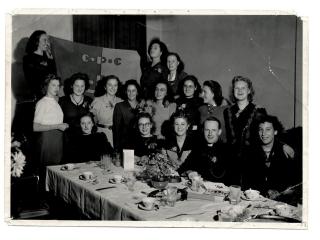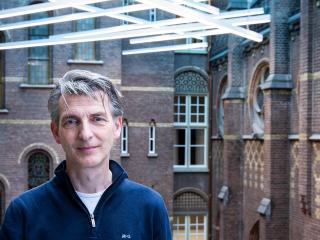First Mechanical Brain in Tilburg
On the second floor of the Goossens Building there is a kind of museum, a small room with all kinds of equipment. It originates from the former computing center and from the contents of the no longer existing audiovisual center (both have become part of Library and Information Services). What this mini museum unfortunately lacks is the very first computer on campus, an IBM 1620.
The purchase of this was big news: Het Nieuwsblad van het Zuiden (the forerunner of the current Brabants Dagblad) made a big deal of this on July 13, 1962, announcing the arrival of a “mechanical memory.” And: "A computing center with a computer will be added to the new Business School". This "first mechanical brain" in Tilburg was mainly intended for "scientific calculations in the field of operations research, in particular linear programming and simulations." But perhaps, according to the newspaper, the business community could also make use of it.
The IBM 1620 was a so-called scientific computer, marketed in America in 1959, which until then could only be found in the Netherlands at the technical universities of Delft and Eindhoven. The fact that Tilburg purchased such a device had everything to do with a Computer Committee established in 1960, which, in November 1961, published the report Gebruiksmogelijkheden van elektronische rekenapparatuur aan de Katholieke Economische Hogeschool (Potential Use of Electronic Computing Equipment at the Roman Catholic Business School). That report was subsequently the basis for the advent of a computing center, for which the contours were sketched by none other than Max Euwe (1901–1981), a mathematician holding a PhD who had become world chess champion in 1935.
The genesis of the Computing Center
At that time, Euwe was director of the Stichting Studiecentrum voor Administratieve Automatisering in Amsterdam and—with his experience as a scientific advisor at the American automation company Remington Rand—was soon seen by the university board, at that time, as the future director of that Computing Center and, moreover, full professor of “Automatic Information Processing.” Euwe was appointed in 1964; the Computing Center had already formally started with an independent board on October 18, 1962. The Center was mainly at the service of the two scientific institutes known to the university at the time: the Dutch Institute for Social Research (IVA) and the Economic Sociological Institute (ESI).
No one foresaw computers dramatically changing the world
The arrival of the Computing Center and the IBM 1620 had to do with increasing demands of science and scholarship” and the ambition to grow into a “research university.” Yet, according to alumnus and Emeritus Professor of Simulation and Information Systems Jack Kleijnen, no one foresaw that computers would dramatically change the world—and scientific disciplines as well. "Thomas Watson, the founder of IBM, expected that his company would only sell a small number of his (very expensive) computers to large customers such as the government. Only much later, relatively cheap mini computers like the VAX were produced; IBM missed the boat. Much later, Apple, HP, and Sun came with their ‘personal’ computers: a computer for everyone, with which you can now make free phone calls, via the Internet.”
Picture: Jack Kleijnen
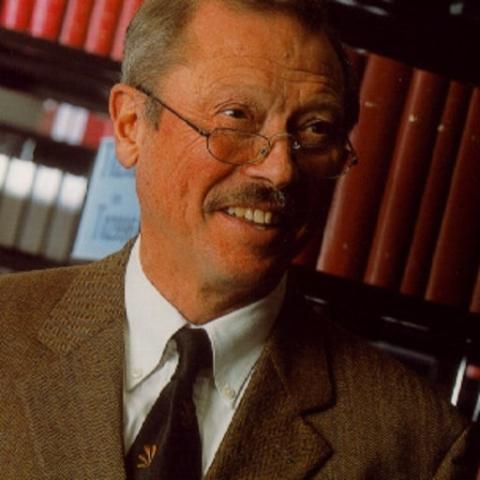
His lecture notes became a reader
After his first year as a student in 1958, Jack Kleijnen specialized in business econometrics, including linear programming and simulation. He attended Euwe’s lectures, who taught, among other things, computer programming—using the programming manuals for Algol 60 and Fortran from the Delft University of Technology. "I graduated in 1964, after which I became an employee at the Economisch Sociologisch Instituut. There I used a computer program to predict the sales of cigars in the Netherlands—a model in which those sales were made dependent on the price of cigars, the price of competing tobacco products, and the national income, among other things.” Kleijnen soon started working at the Roman Catholic Business School itself as a scientific employee for Max Euwe, who at the time made Kleijnen's lecture notes available to students as a reader. In the academic year 1967–1968, Kleijnen was a visiting scientist at the Graduate School of Business Administration of the University of California in Los Angeles (UCLA). They had an IBM computer that was comparable to the IBM 1620, albeit slightly larger and more expensive (because it was paid for by IBM).
The IBM 1620: king size refrigerator with mini memory
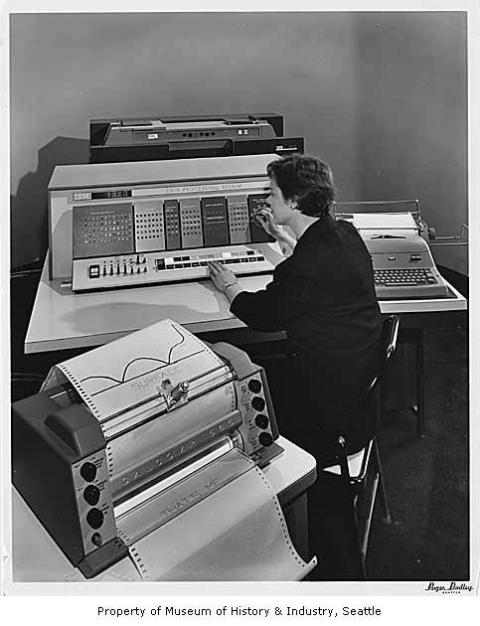
In Tilburg, the Computing Center was now located in the main building at that time, the current Cobbenhagen Building. The IBM 1620 was situated there, and according to Kleijnen, it was a computer of the “second generation.” “As big as a few refrigerators and with a memory of only 32 KB. Another large device for reading punch cards was placed next to the IBM’s CPU (central processing unit). Such a punch machine was able to “read” automated information that was applied to cardboard punch cards with rows of numbers (0 to 9). The positions of the punch holes represented information. The specified data on the cards came from forms filled out by scientists, which were then retyped into punch cards by punch card typists."
Photograph: The punch card typist, in between the IBM 1620, the punch card machine, and the printer.
"I remember that when the punch card reader got stuck, the deputy director of the Computing Center, Ton van Reeken, gave the device a firm kick. And if, as a researcher, you had forgotten a comma, you would not hear about that until the next day—after the punch card typist had done her job, you had handed in the punch card stack to the computer, and this computer would give its results many hours later. The computer did not work online then, but in batch mode. Now computers do almost everything online or in real time, making automated guided vehicles possible, for example. By the way, all current cars are already full of microcomputers that are much more powerful than the good old IBM 1620".
I didn't know the term AI yet
On a number of occasions, Director Max Euwe had spoken disparagingly about the possibilities of computers when it came to chess. He himself played against a computer for the first time on the evening before the congress on the future of computer centers, which was offered to him on December 3, 1970, when he left the university. Euwe won that game, but—in his own words—only just. Four years later, during a stay at the IBM Research Center in San Jose, Jack Kleijnen wrote a computer program for playing a business game. "After I returned to Tilburg, I had that program play against student teams. The computer won the first few rounds of the game, until the students realized that they were playing against a “stupid” computer, which reacted automatically and thus predictably each time. Then they thought of clever ways to win. By the way, I called that program “dummy”; I didn't know the term AI—Artificial Intelligence—yet."
On the photograph at the very top: The reception after the Jack Kleijnen’s PhD defense in 1971. He is congratulated by Max Euwe, his PhD supervisor.
Max Euwe Museum?
In 1971, the Computing Center moved to the Goossens Building, which now houses a small museum, with a rather colorful collection of memorabilia, film equipment, tape recorders, a bulk eraser (with which tapes can be erased), an HP server that unsuspectingly lasted for a long time, and a series of computers from the 1970s, donated by the Psychological Laboratory.
Picture: the punch card machine
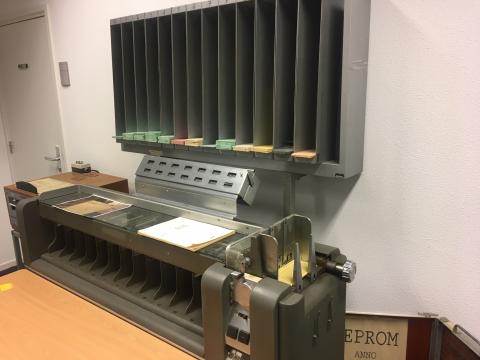
They are—although diverse—objects that say something about a development to which increasing importance is being attached, now that themes such as big data and artificial intelligence are playing an increasingly important role on university agendas. The fact that a room was named after Euwe in the Cobbenhagen Building in 2016 also points to this. Currently, there are plans for both a documentary and for the redesign of the museum. This could perhaps—in a somewhat more extensive form—deal with the history and development of computerization, automation, and artificial intelligence at this university and, who knows, may one day bear the name of Max Euwe.
Also in Tilburg University Magazine
Date of publication: 26 August 2020


